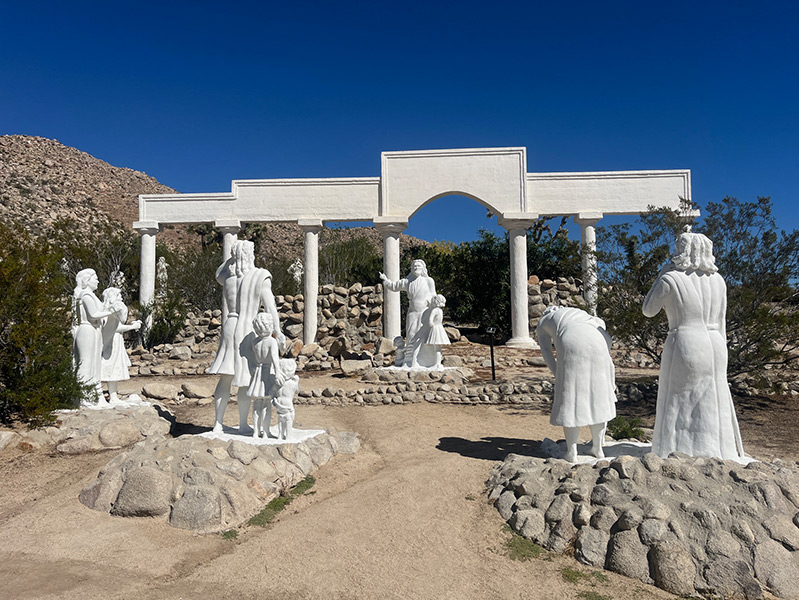Desert Christ Park stands as a singular destination where art, faith, and landscape converge. From the vantage of this hillside garden, visitors are greeted by stark white figures of biblical proportion—statues frozen in concrete, capturing the enduring story of Christ in a place of desert stillness and vast sky.
A Vision Born of Faith & Time
The park’s origin traces to 1950 when Reverend Eddie Garver acquired five acres of southern-facing slope land with the purpose of creating a Christian-themed park dedicated to world peace. Around the same time, Antone Martin—a retired aircraft-industry patternmaker turned sculptor—was constructing a towering statue of Jesus in his Los Angeles driveway. His ambition? A monument to stand at the Grand Canyon rim, but when that site proved unavailable he found his counterpart in Garver. Together they birthed the site that became Desert Christ Park. Wikipedia
On Easter Sunday of 1951 the first statue—a 10-foot, 5-ton figure dubbed “the Unwanted Christ”—arrived by truck and was dedicated amidst the desert light. Over the following decade Martin sculpted more than forty statues in situ, including his spectacular bas-relief of the Last Supper, all set upon a landscape of sagebrush, boulders, and sweeping views.
Experience & Atmosphere
Walking through Desert Christ Park feels like moving through a silent storybook, where each grouping of figures tells a chapter—from the Sermon on the Mount, to the Garden of Gethsemane, to the Ascension. The white concrete forms against the deep azure sky embody a quiet drama, heightened by the starkness of the desert environment. DesertUSA
Visitors often note the feeling of isolation and peace—statues looming, joshua trees and brush around them, and the town of Yucca Valley spread out below. Picnic tables, native‐plant landscaping and open pathways make it a place not only for reflection but also for photography, weddings, or a mindful stop on your way to Joshua Tree National Park. Tripadvisor+1
Preservation & Legacy
Like all outdoor art, Desert Christ Park has faced challenges. The site experienced neglect in the 1980s and 1990s (including an earthquake that damaged many statues), and today its stewardship falls to the volunteer-run Desert Christ Park Foundation, which raises funds for restoration, landscaping and site maintenance. The park continues to be free to the public and remains a testament to human creativity, faith and the indomitable spirit of the high desert.
Visit with Intention: Tips for Enjoyment
- When to go: The park is best visited in daylight hours; the desert sun enhances the white sculptures and the sweeping view of the valley. Tripadvisor
- What to bring: A camera (or phone) for unforgettable photos, water (the desert is dry), and a moment to pause and absorb.
- Etiquette: The park is freely open. Donations are encouraged; respect the works and the environment. Some statues bear scars of time or vandalism—tread lightly. California Through My Lens
- Nearby: Located at 56200 Sunnyslope Drive, Yucca Valley. A quick detour from Highway 62 en route to Joshua Tree gets you there. Roadside America
Why It Matters
In a region renowned for natural grandeur and artistic eccentricity, Desert Christ Park stands out as a place where human ambition meets desert stillness. The very idea of massive concrete figures, set on a quiet hillside outside Yucca Valley, feels at once bold and meditative. The park invites us to reflect—on story, land, community, and meaning—and gives us a place to stop, look up, and feel small in the desert vastness.
Tags: Antone Martin, art in joshua tree, desert christ park, jesus art, Joshua tree, joshua tree art, joshua tree sculpures, sculptures around joshua tree, yucca valley
